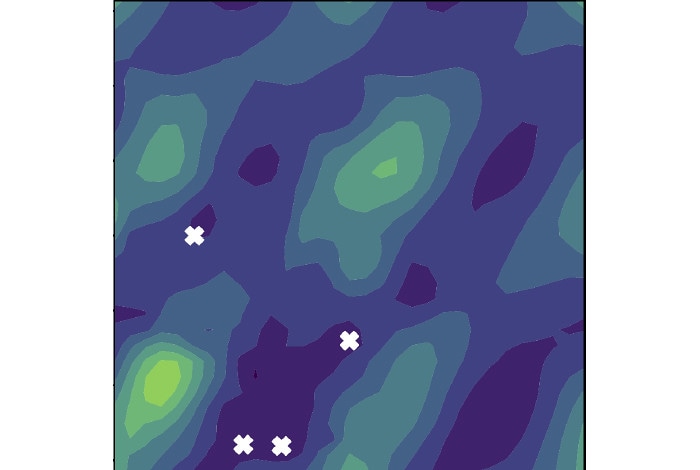Aug 1 2019
Researchers from Los Alamos National Laboratory have created a new quantum computing algorithm that helps gain better insights into the quantum-to-classical transition.
 White crosses represent solutions to a simple quantum problem analyzed with a new quantum computer algorithm developed at the Los Alamos National Laboratory. (Image credit: Los Alamos National Laboratory)
White crosses represent solutions to a simple quantum problem analyzed with a new quantum computer algorithm developed at the Los Alamos National Laboratory. (Image credit: Los Alamos National Laboratory)
The algorithm could further help to model systems that fall between the classical and quantum realms (for example, biological proteins) and also find solutions to questions related to how quantum mechanics is applicable to large-scale objects.
The quantum-to-classical transition occurs when you add more and more particles to a quantum system. such that the weird quantum effects go away and the system starts to behave more classically.
Patrick Coles, Physics of Condensed Matter and Complex Systems group, Los Alamos National Laboratory
Coles continued, “For these systems, it’s essentially impossible to use a classical computer to study the quantum-to-classical transition. We could study this with our algorithm and a quantum computer consisting of several hundred qubits, which we anticipate will be available in the next few years based on the current progress in the field.”
Finding solutions to questions related to the quantum-to-classical transition is extremely difficult. In the case of systems that contain more than a few atoms, the challenge quickly turns intractable. With each additional atom, the number of equations grows exponentially. For instance, proteins are made of long strings of molecules that may become vital biological components or sources of disease, based on the way they fold up.
Despite the fact that proteins can be relatively huge molecules, they are adequately small that the quantum-to-classical transition, and algorithms that can deal with it, turn important when attempting to understand and predict the way proteins fold.
To analyze the elements of the quantum-to-classical transition using a quantum computer, scientists first require an approach for characterizing how close a quantum system is to act classically. Quantum objects possess the properties of both waves and particles.
In certain cases, they interact similar to tiny billiard balls; in other cases, they interfere with each other quite the same way waves on the ocean join to make larger waves or cancel each other out. The wave-like interference is a quantum effect. Luckily, it is possible to describe a quantum system using insightful classical probabilities rather than the more difficult techniques of quantum mechanics, if the interference is absent.
The algorithm developed by the LANL researchers ascertains how close a quantum system is to exhibiting classical behavior. The outcome is a tool that can be used to search for classicality in quantum systems and to gain insights into how quantum systems, eventually, appear classical in day-to-day life.